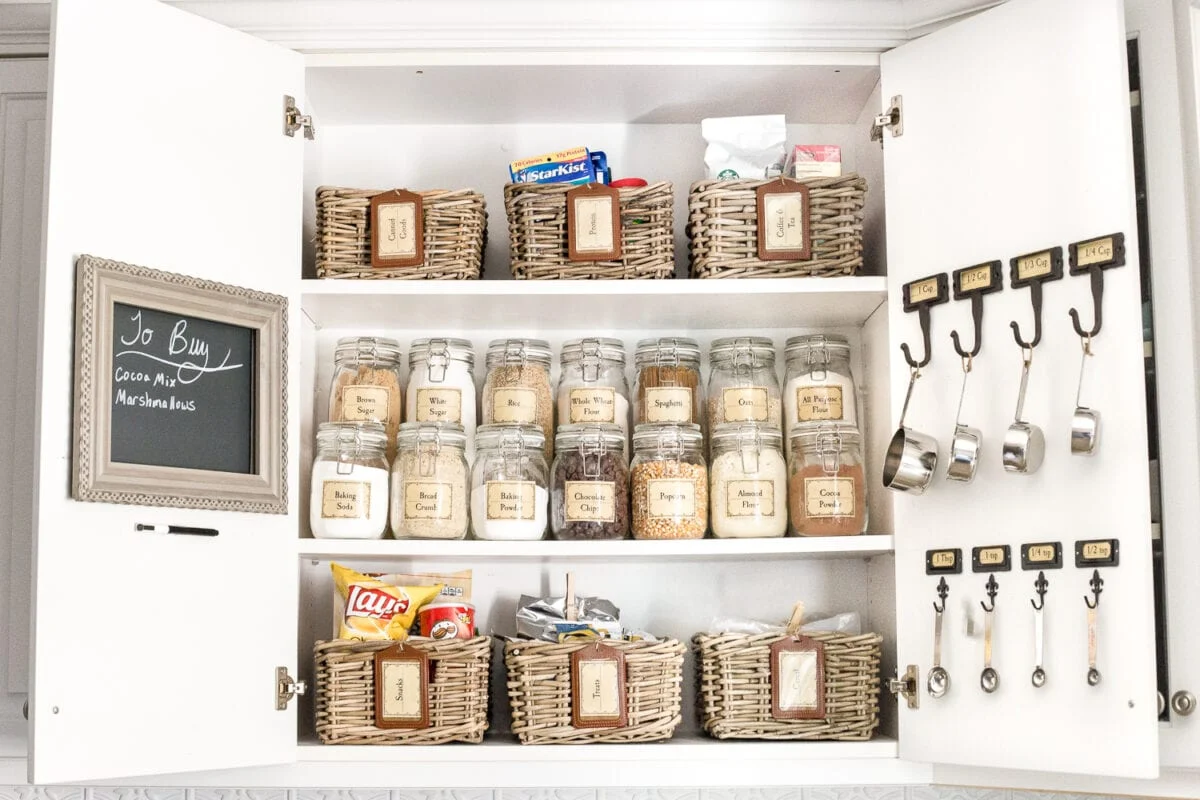An organised pantry is the cornerstone of efficient meal preparation and a stress-free cooking environment. It simplifies the process of finding ingredients, saves time during meal prep, and reduces food waste by keeping track of what you have.
This article will guide you through the essentials of transforming your pantry: from categorising and labelling your items for easy access, to embarking on DIY organisation projects that maximise space and functionality.
Additionally, we’ll provide practical tips for maintaining an orderly pantry, ensuring that once you achieve pantry perfection, it stays that way. Join us as we explore these strategies to enhance your kitchen’s efficiency and make cooking a more enjoyable experience.
Categorising and Labelling Pantry Items
The Basics of Categorisation
Organising pantry items by type not only streamlines the cooking process but also aids in efficient inventory management. By grouping similar items together—such as spices, grains, and canned goods, you minimise the time spent searching for ingredients and can easily keep track of what needs restocking. This methodical approach ensures that everything is within reach when you need it, making meal preparation quicker and more intuitive.
Labelling Like a Pro
Effective labelling transcends mere functionality; it can also contribute to the overall aesthetic of your pantry. Utilise clear, easy-to-read labels that withstand the test of time and handling.
Consider investing in a quality label maker for a professional look, or embrace DIY methods using chalkboard labels or printable tags for a personalised touch. Labels not only help identify items quickly but also maintain a uniform look that enhances the visual appeal of your space. You can shop for kitchen labels that are ready-made in various styles to fit the look you’re going for.
Before and After Examples
The transformation brought about by categorising and labelling is best illustrated through visual examples. Before the organisation, pantries often appear cluttered and chaotic, making it challenging to locate items or gauge what’s in stock.
After implementing these strategies, the same spaces are transformed into orderly havens where every item has a designated place, and the contents of the pantry are visible at a glance. These case studies not only showcase the practical benefits of organisation but also the visual and psychological advantages of having a well-ordered pantry.

DIY Pantry Organisation Projects
Shelving Solutions
Maximising vertical space is key to an efficient pantry. Consider adding extra shelves to accommodate more items without clutter. Adjustable shelving offers flexibility for varying item heights, while wall-mounted racks can free up shelf space for other essentials. These solutions not only increase storage capacity but also improve visibility and access to your pantry items.
Storage Hacks
Utilising baskets, bins, and containers can dramatically enhance pantry organisation. Assign baskets for similar items, such as snack foods or baking ingredients, to keep them grouped together. Use clear bins for easy visibility of contents, and label each container for quick identification. This approach not only keeps your pantry tidy but also makes inventory checks a breeze.
Custom Creations
Engaging in DIY projects like building a spice rack or a can organiser can further tailor your pantry to your specific needs. A homemade spice rack, for example, can be designed to fit your available space and hold all your spices in an organised manner, making them easily accessible. Similarly, a DIY can organiser can help you utilise deep shelf space more efficiently, allowing for easy access and rotation of canned goods. These projects not only add a personal touch to your pantry but also enhance its functionality.
Tips for Maintaining an Efficient Pantry
Routine Checks
Regularly reviewing the contents of your pantry is crucial for maintaining its efficiency. Schedule monthly checks to sift through items, discarding anything expired and noting what essentials need restocking. This practice not only ensures the freshness of your ingredients but also helps in keeping your pantry organised and up-to-date.
Keeping It Tidy
Consistency is key to preserving pantry organisation. Develop daily habits, such as returning items to their designated spots after use and wiping down shelves. Invest in storage solutions that fit your space and needs, like stackable containers or door-mounted racks, to prevent clutter from accumulating. A tidy pantry supports smoother meal preparation and reduces the time spent on cleaning and reorganising.
Seasonal Adjustments
Your pantry should evolve with your cooking habits, which often change with the seasons or dietary preferences. Reevaluate your pantry’s layout and contents with each season, bringing forward items that match your current cooking needs while storing away less frequently used ingredients. This approach not only optimises your pantry space but also encourages variety and creativity in your cooking.
TL:DR
Organising your pantry is a straightforward yet impactful step towards enhancing your kitchen’s functionality and your meal preparation process. By categorising and labelling items, undertaking DIY organisation projects, and maintaining the order with routine checks and seasonal adjustments, you can transform your pantry into a model of efficiency. These strategies not only make cooking and meal planning more manageable but also save time and reduce food waste by keeping track of what you have.
Starting small is the key to sustainable pantry organisation. Even minor adjustments, such as introducing clear labeling or adding a few storage bins, can significantly improve how you use and view your pantry space. Remember, the goal is to create a system that works for you and your household, making meal prep a smoother and more enjoyable experience. Invest a little time into organising your pantry now, and reap the benefits of an efficient, stress-free kitchen environment in the long run.


No Comments